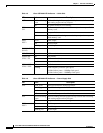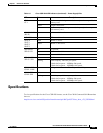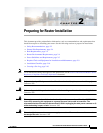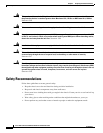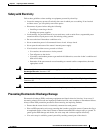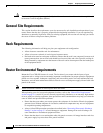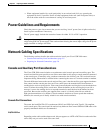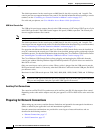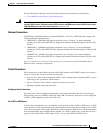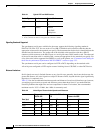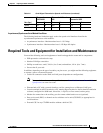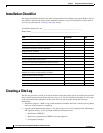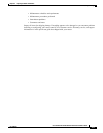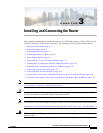
2-6
Cisco 2010 Connected Grid Router Hardware Installation Guide
OL-31454-01
Chapter 2 Preparing for Router Installation
Network Cabling Specifications
The default parameters for the console port are 9600 baud, 8 data bits, no parity, and 1 stop bit. The
console port does not support hardware flow control. For detailed information about installing a console
terminal, see the “Connecting to a Console Terminal or Modem” section on page 3-17.
For cable and port pinouts, see Cisco Modular Access Router Cable Specifications.
USB Serial Console Port
The USB serial console port connects directly to the USB connector of a PC using a USB Type A to 5-pin
mini USB Type-B cable. The USB Console supports full speed (12Mb/s) operation. The console port
does not support hardware flow control.
Note Always use shielded USB cables with a properly terminated shield.
The default parameters for the console port are 9600 baud, 8 data bits, no parity, and 1 stop bit. The
console port does not support mode control. For detailed information about installing a console terminal,
see the “Connecting to a Console Terminal or Modem” section on page 3-17.
For operation with Microsoft Windows, the Cisco Windows USB Console Driver must be installed on
every PC connected to the console port. If the driver is not installed, prompts guide you through a simple
installation process. For detailed information about installing the Cisco Windows USB Console Driver
see “Installing the Cisco Microsoft Windows USB Device Driver” section on page 3-21.
The Cisco Windows USB Console Driver allows plugging and unplugging the USB cable from the
console port without affecting Windows HyperTerminal operations. No special drivers are needed for
Mac OS X or Linux.
Only one console port can be active at a time. When a cable is plugged into the USB console port the
RJ-45 port becomes inactive. Conversely, when the USB cable is removed from the USB port, the RJ-45
port becomes active.
Baud rates for the USB console port are 1200, 2400, 4800, 9600, 19200, 38400, 57600, and 115200 bps.
Note 4-pin mini USB Type-B connectors are easily confused with 5-pin mini USB Type-B connectors.
They are not compatible. Only the 5-pin mini USB Type-B can be used.
Auxiliary Port Connections
The router has an EIA/TIA-232 asynchronous serial auxiliary port (RJ-45) that supports flow control.
Depending on the cable and the adapter used, this port appears as a DTE or DCE device at the end of the
cable.
Preparing for Network Connections
When setting up your router, consider distance limitations and potential electromagnetic interference
(EMI) as defined by the applicable local and international regulations.
Network connection considerations are provided for several types of network interfaces and are
described in the following sections:
• Ethernet Connections, page 2-7
• Serial Connections, page 2-7



